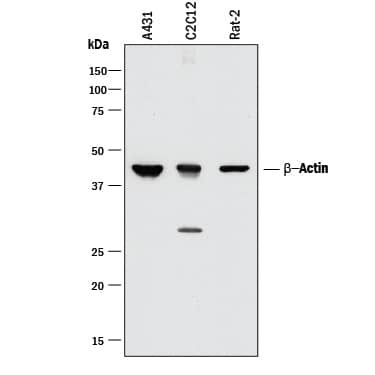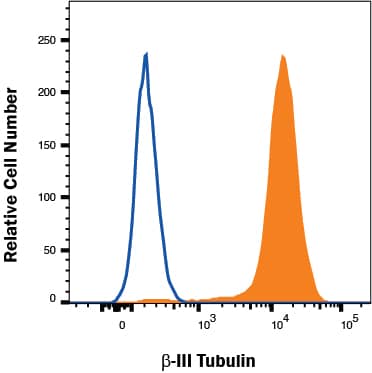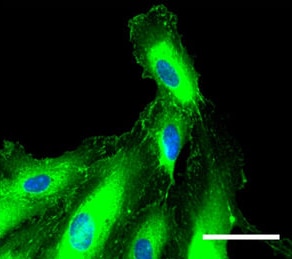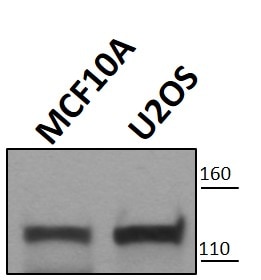Human/Mouse/Rat Vinculin Antibody Summary
Lys1020-Gln1134
Accession # P18206
Customers also Viewed
Applications
Please Note: Optimal dilutions should be determined by each laboratory for each application. General Protocols are available in the Technical Information section on our website.
Scientific Data
 View Larger
View Larger
Detection of Human Vinculin by Western Blot. Western blot shows lysates of HeLa human cervical epithelial carcinoma cell line and HepG2 human hepatocellular carcinoma cell line. PVDF membrane was probed with 2 µg/mL of Mouse Anti-Human Vinculin Monoclonal Antibody (Catalog # MAB6896) followed by HRP-conjugated Anti-Mouse IgG Secondary Antibody (Catalog # HAF007). A specific band was detected for Vinculin at approximately 124 kDa (as indicated). This experiment was conducted under reducing conditions and using Immunoblot Buffer Group 1.
 View Larger
View Larger
Vinculin in Human Uterus. Vinculin was detected in immersion fixed paraffin-embedded sections of human uterus using Mouse Anti-Human Vinculin Monoclonal Antibody (Catalog # MAB6896) at 15 µg/mL overnight at 4 °C. Before incubation with the primary antibody, tissue was subjected to heat-induced epitope retrieval using Antigen Retrieval Reagent-Basic (Catalog # CTS013). Tissue was stained using the Anti-Mouse HRP-DAB Cell & Tissue Staining Kit (brown; Catalog # CTS002) and counterstained with hematoxylin (blue). Specific staining was localized to smooth muscle cells. View our protocol for Chromogenic IHC Staining of Paraffin-embedded Tissue Sections.
 View Larger
View Larger
Detection of Human Vinculin by Simple WesternTM. Simple Western lane view shows lysates of HeLa human cervical epithelial carcinoma cell line and PC‑3 human prostate cancer cell line, loaded at 0.2 mg/mL. A specific band was detected for Vinculin at approximately 122 kDa (as indicated) using 20 µg/mL of Mouse Anti-Human/Mouse/Rat Vinculin Monoclonal Antibody (Catalog # MAB6896). This experiment was conducted under reducing conditions and using the 12-230 kDa separation system.
 View Larger
View Larger
Detection of Human Vinculin by Western Blot Cr and Ni exposure increases tau levels and phosphorylation in iNeurons and RA-differentiated SH-SY5Y cells. (a,b) iPSCs carrying the R406W tau mutation and isogenic controls were differentiated into iNeurons and treated with Cr (5 µM) and Ni (800 µM) for 72 hours. The levels of total (a) and phospho-tauSer396/404 (PHF-1) (b) tau were measured by western blot. GAPDH and vinculin were used as loading controls. Images show representative immunoblots comparing tau and phospho-tau levels in control and mutant iNeurons before and after Cr and Ni treatment. Plots represents the average ± SEM of 3 independent experiments. (c,d) RA-differentiated SH-SY5Y cells were treated with Cr (2.5 µM) and Nickel (200 µM) for 24 hours before protein extraction. Images show representative immunoblots comparing the levels total tau (c) and phospho-tauSer396/404 (PHF-1) tau (d) before and after heavy metals treatment. GAPDH and vinculin were used as loading control. Plots represent the average ± SEM of 4 independent experiments. Statistical significance was determined by two‐ANOVA followed by Bonferroni’s test for multiple comparisons or one-way ANOVA using GraphPad Prism 6. p-values comparing untreated and heavy metal treated cells are included in the graphs. Statistical significance was considered when p-value ≤ 0.05. Image collected and cropped by CiteAb from the following publication (https://pubmed.ncbi.nlm.nih.gov/31953414), licensed under a CC-BY license. Not internally tested by R&D Systems.
 View Larger
View Larger
Detection of Human Vinculin by Western Blot Cr and Ni exposure increases tau levels and phosphorylation in iNeurons and RA-differentiated SH-SY5Y cells. (a,b) iPSCs carrying the R406W tau mutation and isogenic controls were differentiated into iNeurons and treated with Cr (5 µM) and Ni (800 µM) for 72 hours. The levels of total (a) and phospho-tauSer396/404 (PHF-1) (b) tau were measured by western blot. GAPDH and vinculin were used as loading controls. Images show representative immunoblots comparing tau and phospho-tau levels in control and mutant iNeurons before and after Cr and Ni treatment. Plots represents the average ± SEM of 3 independent experiments. (c,d) RA-differentiated SH-SY5Y cells were treated with Cr (2.5 µM) and Nickel (200 µM) for 24 hours before protein extraction. Images show representative immunoblots comparing the levels total tau (c) and phospho-tauSer396/404 (PHF-1) tau (d) before and after heavy metals treatment. GAPDH and vinculin were used as loading control. Plots represent the average ± SEM of 4 independent experiments. Statistical significance was determined by two‐ANOVA followed by Bonferroni’s test for multiple comparisons or one-way ANOVA using GraphPad Prism 6. p-values comparing untreated and heavy metal treated cells are included in the graphs. Statistical significance was considered when p-value ≤ 0.05. Image collected and cropped by CiteAb from the following publication (https://pubmed.ncbi.nlm.nih.gov/31953414), licensed under a CC-BY license. Not internally tested by R&D Systems.
 View Larger
View Larger
Detection of Human Vinculin by Western Blot Cr and Ni exposure induces apoptotic cell death in SH-SY5Y cells. Non-differentiated and RA-differentiated SH-SY5Y cells were treated with Cr (2.5 µM) and Ni (200 µM) for 24 hours. Whole cell lysates were collected in order to analyze by western blot the levels of cleaved caspase-3 protein (a), the ratio of anti-apoptotic protein Bcl2 to pro-apoptotic protein Bax (b) and the cleavage and activation of caspase-9 (c). Vinculin and GAPDH were used as loading controls. (a) Representative immunoblot showing the presence of the 17/19KD fragment of caspase-3 after Cr and Ni exposure. (b) Representative immunoblots showing the levels of Bcl2 and Bax proteins after heavy metal exposure. The activation of the intrinsic/mitochondrial apoptosis pathway was assessed by the decrease of the ratio of Bcl2 to full length Bax and the presence of a cleavage form of Bax protein. The plot represent the average ± SEM of 3 independent experiments. Statistical significance was determined by one-way analysis of variance (anova) followed by Bonferroni’s test for multiple comparisons using GraphPad Prism 6. p-values comparing untreated and heavy metal treated cells are included. Statistical significance was considered when p-value ≤ 0.05. (c) Immunoblot showing the presence of the fragment (43KD) of active caspase-9 after Cr and Ni exposure to confirm the activation of the intrinsic/mitochondrial pathway. All experiments were performed in triplicates. Image collected and cropped by CiteAb from the following publication (https://pubmed.ncbi.nlm.nih.gov/31953414), licensed under a CC-BY license. Not internally tested by R&D Systems.
 View Larger
View Larger
Simple Western: Vinculin Antibody (728526) [Unconjugated] [MAB6896] - Simple Western: Vinculin Antibody (728526) [Unconjugated] [MAB6896] - Western blot analysis for expression levels of mTOR and its downstream factors in the DRG on PID 21. Phosphorylated expressions of mTOR complex 1 and 2 were decreased in the shmTOR group, and its downstream effectors were downregulated as well. Data are expressed as mean +- SEM, * p < 0.05, ** p < 0.01, **** p < 0.0001. One-way ANOVA with Tukey's multiple comparisons test. Image collected and cropped by CiteAb from the following publication (https://pubmed.ncbi.nlm.nih.gov/37958901), licensed under a CC-BY license. Not internally tested by R&D Systems.
Preparation and Storage
- 12 months from date of receipt, -20 to -70 °C as supplied.
- 1 month, 2 to 8 °C under sterile conditions after reconstitution.
- 6 months, -20 to -70 °C under sterile conditions after reconstitution.
Background: Vinculin
VCL (vinculin) is a 117 kDa actin binding cytoskeletal phosphoprotein found in adherens-type cell-cell and cell-matrix junctions. The 1066 amino acid (aa) human vinculin contains an N-terminal globular head (aa 2-835) with a talin interaction domain (aa 168-208) and three tandem repeats (aa 259-589), a pro-rich linker region (aa 826-878), and a C-terminal tail that facilitates phospholipid membrane insertion (aa 1003-1134). An 1134 aa form termed metavinculin contains 68 aa inserted after aa 915 and mainly occurs in cardiac, skeletal and smooth muscle. Human, mouse and rat vinculin share 100% aa sequence identity within the region used as an immunogen.
Product Datasheets
Citations for Human/Mouse/Rat Vinculin Antibody
R&D Systems personnel manually curate a database that contains references using R&D Systems products. The data collected includes not only links to publications in PubMed, but also provides information about sample types, species, and experimental conditions.
19
Citations: Showing 1 - 10
Filter your results:
Filter by:
-
A super-enhancer-regulated RNA-binding protein cascade drives pancreatic cancer
Authors: Corina E. Antal, Tae Gyu Oh, Stefan Aigner, En-Ching Luo, Brian A. Yee, Tania Campos et al.
Nat Commun
-
Directed evolution of a family of AAV capsid variants enabling potent muscle-directed gene delivery across species
Authors: Tabebordbar M, Lagerborg KA, Stanton A et al.
Cell
-
Platelet activating factor receptor regulates colitis-induced pulmonary inflammation through the NLRP3 inflammasome
Authors: Liu, G;Mateer, SW;Hsu, A;Goggins, BJ;Tay, H;Mathe, A;Fan, K;Neal, R;Bruce, J;Burns, G;Minahan, K;Maltby, S;Fricker, M;Foster, PS;Wark, PAB;Hansbro, PM;Keely, S;
Mucosal Immunol
-
A Single Injection of rAAV-shmTOR in Peripheral Nerve Persistently Attenuates Nerve Injury-Induced Mechanical Allodynia.
Authors: Park M, Woo H N et al.
Int J Mol Sci
Species: Rat
Sample Types:
Applications: Simple Western -
Functional analysis of Collagen 17a1: A genetic modifier of junctional epidermolysis bullosa in mice
Authors: Sproule, TJ;Wilpan, RY;Low, BE;Silva, KA;Reyon, D;Joung, JK;Wiles, MV;Roopenian, DC;Sundberg, JP;
PloS one
Species: Mouse, Transgenic Mouse
Sample Types: Tissue Homogenates
Applications: Western Blot -
Deteriorative Effects of Radiation Injury Combined with Skin Wounding in a Mouse Model
Authors: L Wang, B Lin, M Zhai, W Cui, L Hull, A Zizzo, X Li, JG Kiang, M Xiao
Toxics, 2022-12-14;10(12):.
Species: Mouse
Sample Types: Tissue Homogenates
Applications: Western Blot -
Arachidin-1, a Prenylated Stilbenoid from Peanut, Induces Apoptosis in Triple-Negative Breast Cancer Cells
Authors: S Mohammadho, LC Ho, L Fang, J Xu, F Medina-Bol
International Journal of Molecular Sciences, 2022-01-20;23(3):.
Species: Human
Sample Types: Cell Lysates
-
Non-selective TRPC channel inhibition and suppression of aminoglycoside-induced premature termination codon readthrough by the small molecule AC1903
Authors: A Baradaran-, CC Bauer, IB Pickles, S Hosseini-F, AD Balgi, K Choi, DM Linley, DJ Beech, M Roberge, RS Bon
The Journal of Biological Chemistry, 2022-01-06;298(2):101546.
Species: Human
Sample Types: Cell Lysates
Applications: Simple Western -
Trauma-induced heme release increases susceptibility to bacterial infection
Authors: GR Lee, D Gallo, RW Alves de S, S Tiwari-Hec, E Csizmadia, JD Harbison, S Shankar, V Banner-Goo, MB Yaffe, MS Longhi, CJ Hauser, LE Otterbein
JCI Insight, 2021-10-22;0(0):.
Species: Mouse
Sample Types: Tissue Homogenates
Applications: Western Blot -
Small molecule Y-320 stimulates ribosome biogenesis, protein synthesis, and aminoglycoside-induced premature termination codon readthrough
Authors: S Hosseini-F, A Baradaran-, C Zimmerman, K Choi, S Flibotte, M Roberge
PloS Biology, 2021-05-03;19(5):e3001221.
Species: Human
Sample Types: Cell Lysates
Applications: Western Blot -
Filamentous tangles with nemaline rods in MYH2 myopathy: a novel phenotype
Authors: NN Madigan, MJ Polzin, G Cui, T Liewluck, MH Alsharabat, CJ Klein, AJ Windebank, G Mer, M Milone
Acta neuropathologica communications, 2021-04-29;9(1):79.
Species: Human
Sample Types: Tissue Homogenates
Applications: Western Blot -
Effect of small molecule eRF3 degraders on premature termination codon readthrough
Authors: A Baradaran-, AD Balgi, S Hosseini-F, K Choi, C Has, M Roberge
Nucleic Acids Research, 2021-04-19;0(0):.
Species: Human
Sample Types: Cell Lysates
Applications: Western Blot -
A Dynamic, Split-Luciferase-Based Mini-G Protein Sensor to Functionally Characterize Ligands at All Four Histamine Receptor Subtypes
Authors: C Höring, U Seibel, K Tropmann, L Grätz, D Mönnich, S Pitzl, G Bernhardt, S Pockes, A Strasser
Int J Mol Sci, 2020-11-10;21(22):.
Species: Human
Sample Types: Cell Lysates
Applications: Western Blot -
SILAC Analysis Reveals Increased Secretion of Hemostasis-Related Factors by Senescent Cells
Authors: CD Wiley, S Liu, C Limbad, AM Zawadzka, J Beck, M Demaria, R Artwood, F Alimirah, JA Lopez-Domi, C Kuehnemann, SR Danielson, N Basisty, HG Kasler, TR Oron, PY Desprez, SD Mooney, BW Gibson, B Schilling, J Campisi, P Kapahi
Cell Rep, 2019-09-24;28(13):3329-3337.e5.
Species: Human
Sample Types: Cell Culture Supernates
Applications: Western Blot -
Establishing a Split Luciferase Assay for Proteinkinase G (PKG) Interaction Studies
Authors: A Schramm, P Mueller-Th, T Littmann, M Harloff, T Ozawa, J Schlossman
Int J Mol Sci, 2018-04-12;19(4):.
Species: Mouse
Sample Types: Tissue Homogenates
Applications: Western Blot -
Gentamicin B1 is a minor gentamicin component with major nonsense mutation suppression activity
Authors: A Baradaran-, J Niesser, AD Balgi, K Choi, C Zimmerman, AP South, HJ Anderson, NC Strynadka, MB Bally, M Roberge
Proc. Natl. Acad. Sci. U.S.A, 2017-03-13;0(0):.
Species: Mouse
Sample Types: Tissue Homogenates
Applications: Western Blot Control -
Novel small molecules potentiate premature termination codon readthrough by aminoglycosides.
Authors: Alireza Baradaran-, Aruna D Balgi, Carla Zimmerman, Kunho Choi, Fahimeh S Shidmooss, Jason S Tan, Célia Bergeaud, Alexandra Krause, Stéphane Flibotte, Yoko Shimizu, Hilary J Anderson, Vincent Mouly, Eric Jan, Tom Pfeifer, James B Jaquith, Michel Roberge
Nucleic Acids Research, 2016-07-12;0(0):1362-4962.
Species: Human
Sample Types: Cell Lysates
Applications: Western Blot -
Increased reliance on muscle based thermogenesis upon acute minimization of brown adipose tissue function
Authors: Naresh C Bal
J Biol Chem, 2016-06-13;0(0):.
Species: Mouse
Sample Types: Tissue Homogenates
Applications: Western Blot -
Study of Antibodies to Cytolethal Distending Toxin B (CdtB) and Antibodies to Vinculin in Patients with Irritable Bowel Syndrome
Authors: Maysaa El Sayed Zaki, Dina Elhammady, Mona Foda Salama, Mostafa Abdelsalam, Asmaa Osama Bakr Osman
F1000Research
FAQs
No product specific FAQs exist for this product, however you may
View all Antibody FAQsReviews for Human/Mouse/Rat Vinculin Antibody
Average Rating: 4.5 (Based on 6 Reviews)
Have you used Human/Mouse/Rat Vinculin Antibody?
Submit a review and receive an Amazon gift card.
$25/€18/£15/$25CAN/¥75 Yuan/¥2500 Yen for a review with an image
$10/€7/£6/$10 CAD/¥70 Yuan/¥1110 Yen for a review without an image
Filter by:
Paraformaldehyde-fixed fibroblast stained with vinculin (red), and counterstained with DAPI (blue)


















